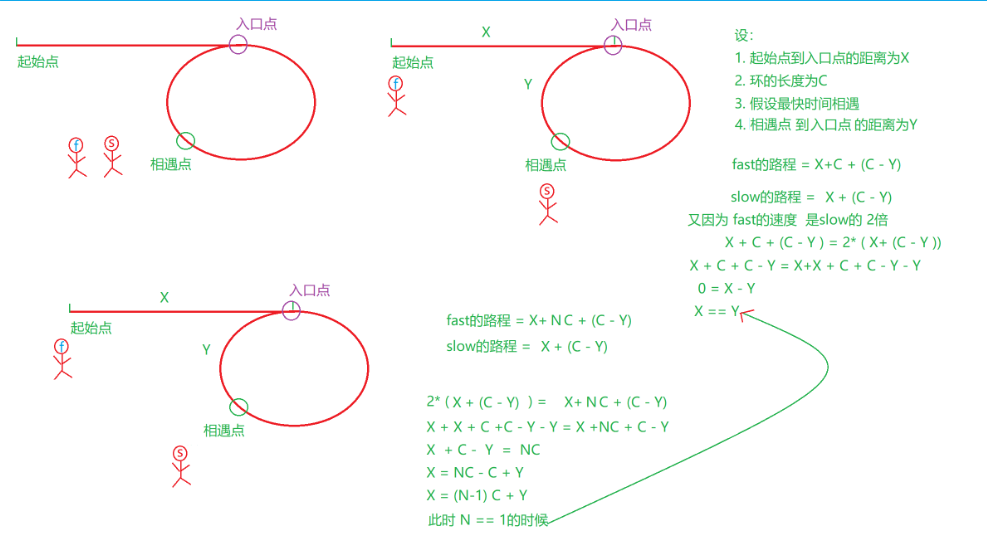1.链表
1.1链表的概念和结构
链表是一种物理存储结构上非连续 存储结构,数据元素的逻辑顺序 是通过链表中引用链接次序实现的。
这里大多讨论无头单向非循环链表。这种结构,结构简单,一般与其他数据结构结合,作为其他数据结构的子数据。
1.2链表的实现
java
public class MysingleList {
static class ListNode{
public int val;//节点的值域
public ListNode next;//下一个节点为地址
public ListNode(int val){
this.val=val;
}
}
public ListNode head;//当前链表的头节点
public void createList(){
ListNode node1 = new ListNode(12);
ListNode node2 = new ListNode(23);
ListNode node3 = new ListNode(34);
ListNode node4 = new ListNode(45);
ListNode node5 = new ListNode(56);
node1.next = node2;
node2.next = node3;
node3.next = node4;
node4.next = node5;
this.head = node1;
}
}1.3方法
这里仍然尝试自己创建方法了解一些基础的操作
java
//头插法
public void addFirst(int data){
ListNode node=new ListNode(data);
node.next=head;
head=node;
}
//尾插法
public void addLast(int data){
ListNode node=new ListNode(data);
ListNode cur=head;
if (cur==null){
head=node;
return ;
}
while(cur.next!=null){
cur=cur.next;
}
cur.next=node;
}
//任意位置插入,第一个数据节点为0号下标
public void addIndex(int index,int data) {
if (index<0||index>size()){
System.out.println("位置不合法");
return;
}
if (index==0){
addFirst(data);
}
if (index==size()){
addLast(data);
}
ListNode node = new ListNode(data);
ListNode cur=findIndex(index);
node.next=cur.next;
cur.next=node;
}
private ListNode findIndex(int index){
ListNode cur=head;
int count=0;
while (cur!=null){
cur=cur.next;
count++;
if (count==index-1){
break;
}
}
return cur;
}
//查找是否包含关键字key是否在单链表当中
public boolean contains(int key){
ListNode cur=head;
while (cur!=null){
if(cur.val==key){
return true;
}
cur=cur.next;
}
return false;
}
//删除第一次出现关键字为key的节点
public void remove(int key){
if (head==null){
return;
}
if (head.val==key){
head=head.next;
return;
}
ListNode cur=findKey(key);
if(cur==null){
System.out.println("没有对应的数值");
return ;
}
ListNode del=cur.next;
cur.next=del.next;
}
private ListNode findKey(int key){
ListNode cur=head;
while (cur.next!=null){
if (cur.next.val==key){
return cur;
}
cur=cur.next;
}
return null;
}
//删除所有值为key的节点
public void removeAllKey(int key){
if (head==null){
return;
}
ListNode cur=head.next;
ListNode pre=head;
while(cur!=null){
if(cur.val==key){
pre.next=cur.next;
cur=cur.next;
}else {
pre=cur;
cur=cur.next;
}
}
if (head.val==key){
head=head.next;//需要放在最后不然找不到后面的数据了。
}
}
//得到单链表的长度
public int size(){
int count=0;
ListNode cur=head;
while(cur!=null){
count++;
cur=cur.next;
}
return count;
}
public void clear() {
this.head=null;
}
public void display() {
ListNode cur=head;
while(cur!=null){
System.out.print(cur.val+" ");
cur=cur.next;
}
System.out.println();
}另外在管理员中使用jps可以显示当前系统中所有正在运行的 Java 进程的 进程 ID(PID) 和 主类名 或 JAR 包名。jmap语言可以用于查看 Java 进程的内存使用情况、生成堆转储(heap dump)等。
这里再补充几道常见链表操作的题目:
这一题可以使用快慢指针,快指针永远是慢支针步数的两倍。
java
class Solution {
public ListNode middleNode(ListNode head) {
if(head==null){return null;}
if(head.next==null){return head;}
ListNode fast=head;
ListNode slow=head;
while(fast!=null&&fast.next!=null){
fast=fast.next.next;
slow=slow.next;
}
return slow;
}
}
java
class Solution {
public ListNode reverseList(ListNode head) {
if(head==null){
return null;
}
if(head.next==null){
return head;
}
ListNode cur=head.next;
head.next=null;
while(cur!=null){
ListNode curNext=cur.next;//保存下一个节点
cur.next=head;
head=cur;
cur=curNext;
}
return head;
}
}
java
class Solution {
public boolean isPalindrome(ListNode head) {
ListNode fast=head;
ListNode slow=head;
//找到中间节点
while (fast!=null && fast.next!=null){
fast=fast.next.next;
slow=slow.next;
}
//翻转后半部分的链表
ListNode cur=slow.next;
while(cur!=null){
ListNode curNext=cur.next;
cur.next=slow;
slow=cur;
cur=curNext;
}
//判断回文
while(head!=slow){
if(head.val!=slow.val){
return false;
}
if(head.next==slow){return true;}
head=head.next;
slow=slow.next;
}
return true;
}
}
java
public ListNode partition(ListNode pHead, int x) {
// write code here
ListNode bs = null;
ListNode be = null;
ListNode as = null;
ListNode ae = null;
ListNode cur = pHead;
//没有遍历完 整个链表
while(cur != null) {
if(cur.val < x) {
//第一次插入
if(bs == null) {
bs = be = cur;
}else {
be.next = cur;
be = be.next;
}
}else {
//第一次插入
if(as == null) {
as = ae = cur;
}else {
ae.next = cur;
ae = ae.next;
}
}
cur = cur.next;
}
//第一个段 没有数据
if(bs == null) {
return as;
}
be.next = as;
//防止 最大的数据 不是最后一个
if(as!=null) {
ae.next = null;
}
return bs;
}
java
public class Solution {
public boolean hasCycle(ListNode head) {
if(head==null){
return false;
}
ListNode fast=head;
ListNode slow=head;
while(fast!=null&&fast.next!=null){
fast=fast.next.next;
slow=slow.next;
if(fast==slow){
return true;
}
}
return false;
}
}一定是Y型
java
public class Solution {
public ListNode getIntersectionNode(ListNode headA, ListNode headB) {
int lenA=0;
int lenB=0;
ListNode pl=headA;
ListNode ps=headB;
while(pl!=null){
lenA++;
pl=pl.next;
}
while(ps!=null){
lenA++;
ps=ps.next;
}
pl=headA;
ps=headB;
int len=lenA-lenB;
if(len<0){
pl=headB;
ps=headA;
len=lenB-lenA;//让len能够一定是正数
}
}
//让最长的链表先走差值步
while(len>0){
pl=pl.next;
len--;
}
//找到相遇的点
while(pl!=ps){
pl=pl.next;
ps=ps.next;
}
return pl;
}
java
public class Solution {
public ListNode detectCycle(ListNode head) {
if(head==null){
return null;
}
ListNode fast=head;
ListNode slow=head;
while(fast!=null&&fast.next!=null){
fast=fast.next.next;
slow=slow.next;
if(fast==slow){
break;
}
}
if(fast==null||fast.next==null){
return null;
}
fast=head;
while(fast!=slow){
fast=fast.next;
slow=slow.next;
}
return fast;
}
}2.LinkedList
2.1概念
LinkedList的底层是双向链表结构,由于链表没有将元素储存在连续空间中,元素存储在单独节点中,通过引用将节点链接,因此在进行插入和删除元素的操作的时候,不需要搬移元素,效率较高。
2.2方法
为帮助理解常用方法的底层逻辑,这里再自己对方法进行实现。
java
public class MyLinkList {
//双向链表
static class ListNode{
private int val;
private ListNode prev;
private ListNode next;
public ListNode(int val) {
this.val=val;
}
}
public ListNode head;
public ListNode last;
//得到单链表的长度
public int size(){
ListNode cur=head;
int count=0;
while(cur!=null){
count++;
cur=cur.next;
}
return count;
}
public void display(){
ListNode cur=head;
while(cur!=null){
System.out.print(cur.val+" ");
cur=cur.next;
}
System.out.println();
}
//查找是否包含关键字key是否在单链表当中
public boolean contains(int key){
ListNode cur=head;
while(cur!=null){
if (cur.val==key){
return true;
}
cur=cur.next;
}
return false;
}
//头插法
public void addFirst(int data){
ListNode node=new ListNode(data);
if (head==null){
head=node;
last=node;
}else{
node.next=head;
head.prev=node;
head=node;
}
}
//尾插法
public void addLast(int data){
ListNode node=new ListNode(data);
if (head==null){
head=node;
last=node;
}else {
last.next=node;
node.prev=last;
last=last.next;
}
}
//任意位置插入,第一个数据节点为0号下标
public void addIndex(int index,int data){
checkIndex(index);
if (index==0){
addFirst(data);
}
if (index==size()){
addLast(data);
}
ListNode cur=findIndex(index);
ListNode node=new ListNode(data);
node.next=cur.next;
cur.prev.next=node;
node.prev=cur.prev;
cur.prev=node;
}
private void checkIndex(int index){
if (index<0||index>size()){
throw new IndexOutOfException("index位置不合法");
}
}
private ListNode findIndex(int index){
ListNode cur=head;
while(index !=0){
cur=cur.next;
index--;
}
return cur;
}
//删除第一次出现关键字为key的节点
public void remove(int key){
ListNode cur=head;
while (cur!=null){
if (cur.val==key){
if (cur==head){//如果头节点正好是目标节点
head=head.next;//如果只有这一个节点则为空
if (head!=null){
head.prev=null;
}else {
last=null;
}
}else {
//中间节点
if (cur.next!=null){
cur.prev.next=cur.next;
cur.next.prev=cur.prev;
}else {
//如果正好是last为目标节点
cur.prev.next=cur.next;
last=last.prev;
}
}
return ;
}else {
cur=cur.next;
}
}
}
//删除所有值为key的节点
public void removeAllKey(int key){
ListNode cur=head;
while (cur!=null){
if (cur.val==key){
if (cur==head){//如果头节点正好是目标节点
head=head.next;//如果只有这一个节点则为空
if (head!=null){
head.prev=null;
}else {
last=null;
}
}else {
//中间节点
if (cur.next!=null){
cur.prev.next=cur.next;
cur.next.prev=cur.prev;
}else {
//如果正好是last为目标节点
cur.prev.next=cur.next;
last=last.prev;
}
}
cur=cur.next;
}
}
}
public void clear(){
ListNode cur=head;
while(cur!=head){
ListNode curNext=cur.next;//保存一下
cur.prev=null;
cur.next=null;
cur=curNext;
}
head=null;
last=null;
}
}2.3LinkedList的使用
LinkedList实现了List接口。
1.LinkedList的构造
LinkedList() --无参构造
public LinkedList(Collection<? extends E> c) -- 使用其他集合容器中元素构造 List
java
public static void main(String[] args) {
List<Integer>list1=new LinkedList<>();
list1.add(1);
list1.add(2);
list1.add(3);
}2.4遍历
java
public static void main(String[] args) {
List<Integer>list1=new LinkedList<>();
list1.add(1);
list1.add(2);
list1.add(3);
for (int x: list1) {
System.out.print(x+" ");
}
System.out.println();
ListIterator<Integer>it=list1.listIterator();
while (it.hasNext()){
System.out.print(it.next()+" ");
}
System.out.println();
ListIterator<Integer>it2=list1.listIterator(list1.size());
while (it.hasPrevious()){
System.out.print(it.previous()+" ");
}
System.out.println();
}2.5ArrayList和LinkedList的区别
又可以说是链表和顺序表的区别
|---------|-----------------|------------------------|
| 不同点 | ArrayList | LinkedList |
| 存储空间上 | 物理地址上连续 | 逻辑上连续,但物理地址不一定连续 |
| 随机访问 | 支持O(1) | 不支持:O(N) |
| 头插法 | 需要搬移元素,效率低 O(N) | 只需要修改引用的指向,时间复杂度为 O(1) |
| 插入法 | 空间不够,需要进行扩容 | 没有容量 |
| 应用场景 | 元素高效存储,频繁访问 | 任意位置插入和删除频繁 |